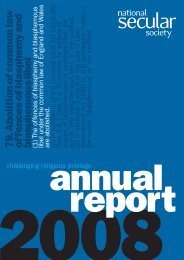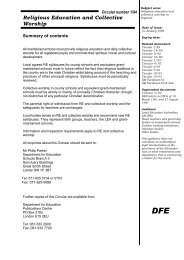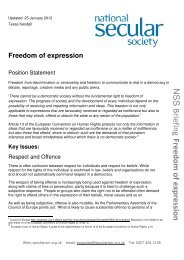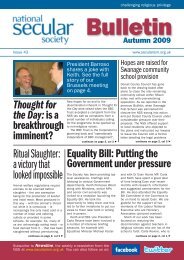European Parliament Platform for Secularism in Politics Seminar at ...
European Parliament Platform for Secularism in Politics Seminar at ...
European Parliament Platform for Secularism in Politics Seminar at ...
Create successful ePaper yourself
Turn your PDF publications into a flip-book with our unique Google optimized e-Paper software.
projected to drop to less than 0.2 million by 2050. 200,000 very elderly congregants each Sunday are not<br />
remotely enough to susta<strong>in</strong> two n<strong>at</strong>ionwide religious <strong>in</strong>stitutions.<br />
The equivalent figures <strong>for</strong> those less than 20 years old are even more dram<strong>at</strong>ic: 1.7 million <strong>in</strong> 1990, 0.5 million<br />
<strong>in</strong> 2010 and 14,300 <strong>in</strong> 2050.<br />
Northern Ireland<br />
There are major n<strong>at</strong>ional and regional vari<strong>at</strong>ions with<strong>in</strong> the United K<strong>in</strong>gdom. The most notable of these is the<br />
much higher degree of religious belief and adherence <strong>in</strong> Northern Ireland, perhaps itself a problem <strong>in</strong> th<strong>at</strong> the<br />
high level of religious belief and sense of identity probably contributes to the cont<strong>in</strong>u<strong>in</strong>g sectarian problems.<br />
While armed hostilities are now much less common, the so-called peace walls <strong>in</strong> Belfast rema<strong>in</strong> by common<br />
consent, and <strong>in</strong>deed still seem necessary. In such a clim<strong>at</strong>e, the need <strong>for</strong> non-sectarian educ<strong>at</strong>ion is too<br />
obvious to st<strong>at</strong>e. It has been acknowledged, and there is an <strong>in</strong>tegr<strong>at</strong>ed schools movement; essentially their<br />
schools are religious schools, but nondenom<strong>in</strong><strong>at</strong>ional. Yet only 5% of pupils <strong>at</strong>tend such schools, which we<br />
suspect are generally not <strong>in</strong> the areas where they are most needed.<br />
Scotland<br />
Scotland is less religious than Northern Ireland but more religious than England and Wales. The local authority<br />
run schools are called “non-denom<strong>in</strong><strong>at</strong>ional schools”, but despite the title are probably the nearest to secular<br />
schools th<strong>at</strong> the United K<strong>in</strong>gdom gets. There are legal provisions <strong>for</strong> religious observance, but much less<br />
prescriptive than the almost-obsessive daily worship requirement imposed by law on all publicly funded<br />
English schools. Such daily worship would not be unlawful <strong>in</strong> Scotland, but the less prescriptive legisl<strong>at</strong>ion is<br />
presumably born out of dissent<strong>in</strong>g views <strong>in</strong> the absence of a powerful established church with its bishops <strong>in</strong><br />
<strong>Parliament</strong>. (The Church of Scotland is generally regarded as the n<strong>at</strong>ional Church. It does not have bishops. All<br />
26 bishops entitled to sit <strong>in</strong> the UK <strong>Parliament</strong> are from the Church of England, and of course all male.)<br />
England<br />
As England is by far the largest jurisdiction, I will concentr<strong>at</strong>e my rema<strong>in</strong><strong>in</strong>g remarks on England.<br />
Despite the dram<strong>at</strong>ic reduction <strong>in</strong> churchgo<strong>in</strong>g by young people (71% between 1990 and 2010), the<br />
proportion of publicly funded religious schools is actually grow<strong>in</strong>g, because the Government is k<strong>in</strong>dly disposed<br />
to religious schools.<br />
Given these figures, it would be reasonable to assume th<strong>at</strong> the religious schools would be almost devoid of<br />
pupils, but the opposite is the case. Religious schools are popular, and many are oversubscribed - but why?<br />
The answer is th<strong>at</strong>, unlike community schools (those run by the local authority without a specifically religious<br />
ethos), many of the religious schools are permitted to select pupils. Official st<strong>at</strong>istics and academic studies<br />
show th<strong>at</strong> this results <strong>in</strong> them cherry-pick<strong>in</strong>g the most promis<strong>in</strong>g pupils, or <strong>at</strong> least avoid<strong>in</strong>g disruptive and<br />
difficult-to-teach pupils. On average there<strong>for</strong>e, unsurpris<strong>in</strong>gly, the exam<strong>in</strong><strong>at</strong>ion results of religious schools<br />
tend to be better than community schools. This is because aspirant parents - the biggest predictor of their<br />
child’s academic success - are keen, even if they are not religious, <strong>for</strong> their children to <strong>at</strong>tend such schools.<br />
This illusory cycle of advantage has a victim: community schools. They take the children not selected by the<br />
religious schools; and it is surpris<strong>in</strong>g th<strong>at</strong> the disparity <strong>in</strong> results compared with religious schools is not much<br />
larger.<br />
Wh<strong>at</strong> the vast majority of parents want is good schools, not religious schools. Such is the pressure on places <strong>in</strong><br />
religious schools, they are often able to make unreasonable demands on parents as a condition of admitt<strong>in</strong>g<br />
their child to school. We are even aware of a school th<strong>at</strong> requires parents to <strong>at</strong>tend the school’s church 48<br />
times per year. It has become an accepted part of middle-class life <strong>for</strong> parents to <strong>at</strong>tend church when they<br />
would not otherwise do so, simply to secure admission <strong>for</strong> their child to the local church school. When do<strong>in</strong>g<br />
so they often make ostent<strong>at</strong>ious don<strong>at</strong>ions and volunteer to per<strong>for</strong>m unpaid work <strong>for</strong> the church. Given this,<br />
it is remarkable th<strong>at</strong> the church <strong>at</strong>tendance figures cont<strong>in</strong>ue their dram<strong>at</strong>ic decl<strong>in</strong>e.<br />
The many families th<strong>at</strong> are not religious, and not prepared to pretend th<strong>at</strong> they are, are seriously<br />
disadvantaged <strong>in</strong> the educ<strong>at</strong>ion system. In rural areas <strong>in</strong> particular, the only school with<strong>in</strong> practical travell<strong>in</strong>g<br />
distance will often be local church school. Even where a family lives close to the school, parents may have















